Gigabyte GA-Z77X-UD5H Review: Functionality meets Competitive Pricing
by Ian Cutress on July 25, 2012 5:00 AM EST- Posted in
- Motherboards
- Gigabyte
- Z77
Gigabyte GA-Z77X-UD5H Software
Gigabyte motherboard software has been stagnant for a couple of generations now - nothing new to the plate, and the same interfaces greet us every installation. The only item that ever changes is the stability, and the ability of these programs to work with new chipsets. Alas, that remains true of the Z77X-UD5H.
The default CD installer gives the user the one-click option to install all drivers, and offers users to install relevant software as well. There is one drawback here - some of the more esoteric software (3D Power, @BIOS) is not installed. These have to be installed one-by-one manually by navigating through. However, a user may not ever notice this software, as after installation and reboot, the CD installer does not re-emerge. Odd.
EasyTune6
The main heart of Gigabyte's software package, as it has been for a while, is EasyTune6. This sort-of centralized bit of software allows users to adjust many of the CPU BIOS settings from software, as well as examine their system and adjust fan controls.
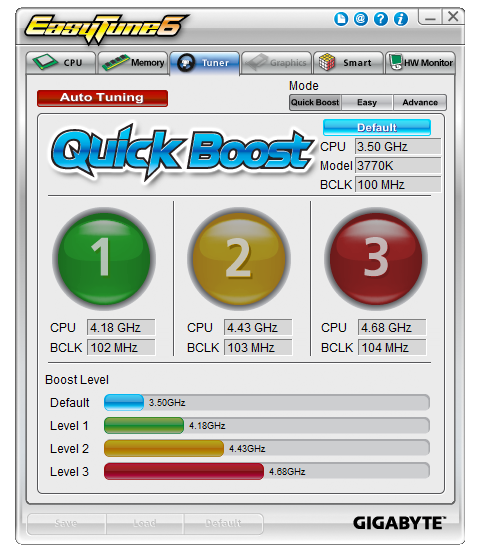
The first screen offers the user a series of pre-determined overclocks, hard written into the program. Our successes with these are varied, as will be explained in the overclocking section. The "Auto Tuning" option in red has nothing to do with adjusting sound (a la AutoTune), but attempts to manually increase the CPU speed according to temperature sensors and stress testing. Again, our experiences with this are detailed in the overclock section. Users can navigate to the 'Easy' and 'Advanced' sections for more detailed and specific options relating to speeds and voltages.
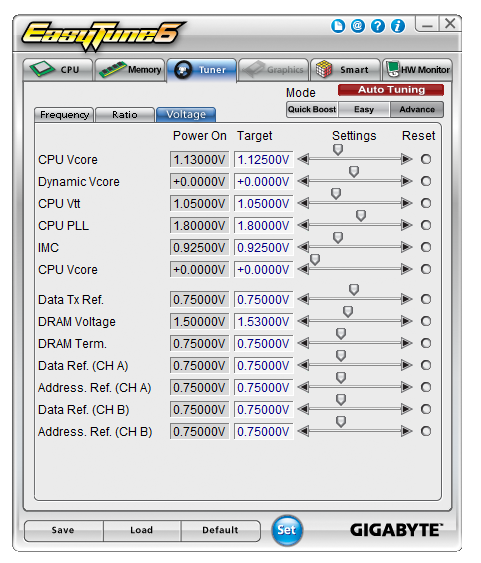
Aside from the monitoring software, EasyTune6 also allows for fan manipulation under the "Smart" tab:

These are very basic fan controls, with a very basic graphical representation. On the Z77X-UD5H, the CPU fan and the SYS fans can be controlled in groups. This means that the SYS fans are all controlled at the same time. When put head-to-head against the best motherboard fan controls available on the market, the Gigabyte board loses out big time.
EasyTune6 also has one big flaw, which has sprung up in my testing several times over the past year. Any software that includes monitoring tools has a large effect on how the CPU processes Deferred Procedure Calls (DPC). These calls are queued in line with priority - IO gets given a priority, monitoring gets given a priority, audio gets a priority. The issue comes with comparing the DPC Latency when these monitoring tools are active. In the BIOS, the monitoring tools are given high priority at the expense of everything else, causing a 20x increase in the latency of other signals, for example audio. This means that during monitoring, the audio could have a large (>3ms) direct latency between production and output. This is severely detrimental to audio fans and producers - in order to get rid of this delay, the monitoring software must be switched off. I have seen this effect with other manufacturers, not just Gigabyte, and their solution was a new BIOS which gives the monitoring tools a lower priority in the DPC process, which fixed the problem and allowed users to run the monitoring tools with no direct effect on DPC. This has been forwarded to Gigabyte, so audio enthusiasts may want to update beyond the F8 BIOS should you purchase this board.
Windows Gadgets
Along with the default install, Gigabyte decided to put two icons on the screen to install two Windows Gadgets. The first of these is for EAX Advanced HD 5.0, which rather than actually doing anything just provides some PR regarding the fact that the Z77X-UD5H confirms to the EAX 5.0 standards. The other gadget is a little more useful, being a SoundBlaster media player. This can be synchronized to a folder of choice and involves simple navigation tools.
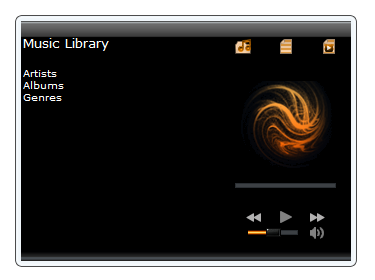
@BIOS
Gigabyte's BIOS updating tool, @BIOS, also makes an appearance. Should Gigabyte decide to perform a major BIOS update, major enough that the Q-Flash utility in the BIOS not recognize the BIOS as being for the motherboard, then users will have to resort to @BIOS. It also acts as a useful tool to check that your system is as up-to-date regarding BIOS releases.
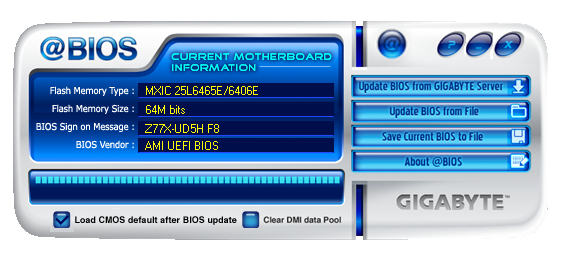
It is simple and easy to use - I have had to use it on occasion.
3D Power
The oddball in Gigabyte's arsenal of software is 3D Power. We were introduced to this utility while the 3D BIOS was still in its infancy, when 3D Power was confusing and slow. While the 3D BIOS has been updated significantly to be fast and accurate, the 3D Power software is left lagging behind, as if it was designed as part of a student's flash project.
Along with being slow and rough around the edges, 3D Power gives users the option to configure the power delivery of the motherboard. This brings up two issues - the first being that most users or enthusiasts will not be adjusting the power delivery options; and the second issue is that if an enthusiast wants to change the options, they would do so in the BIOS and not through a software utility, especially one that is slow and rough. As part of the software package, 3D Power needs a lot of work to be at least visually appealing.


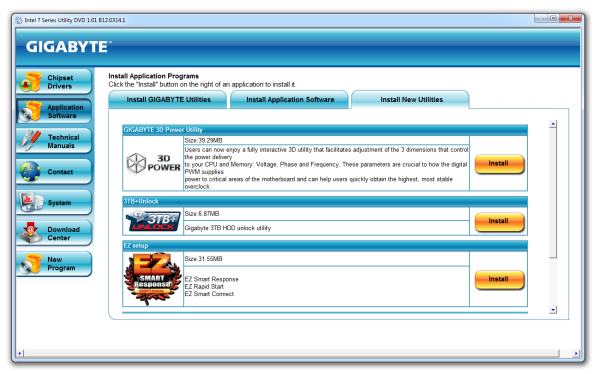
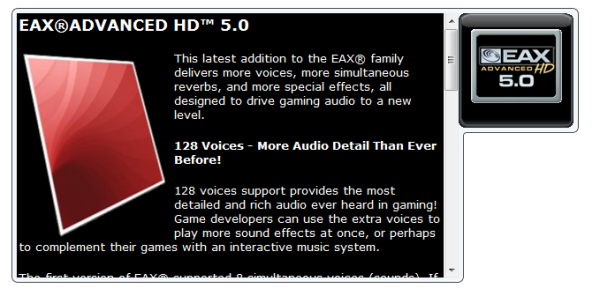
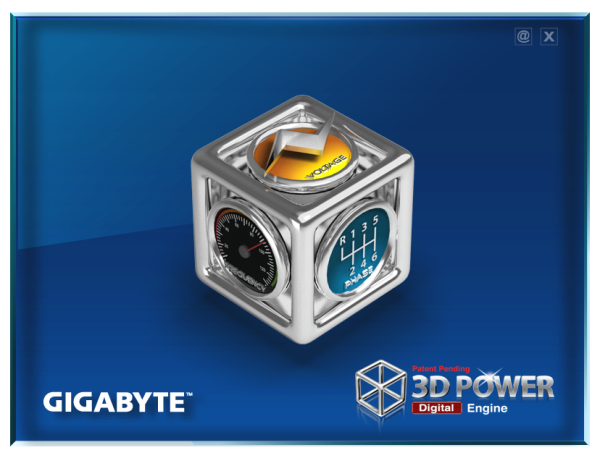














70 Comments
View All Comments
Dustin Sklavos - Wednesday, July 25, 2012 - link
Derp. Well, color me stupid.Nice one, though. ;)
Belard - Thursday, July 26, 2012 - link
Okay, you are stupid.Well, for another reason. Nobody makes a keyboard worthwhile to replace the one I use today... 1996 era. This keyboard *IS SO OLD*, its not even a PS/2! Its an AT-connector, plugged into a PS/2 3" Adapter into an extended PS/2 cable. A USB convert doesn't work.
But gigabyte makes many boards with ps/2 ports.
VGA is not needed on a high end board (lower end $60~120 boards have VGA).
And actually, a floppy connector *IS NOT* needed of modern boards. When a modern board like Gigabyte doesn't include a floppy connector, they can update the BIOS from within the OS or with a flash drive.... far easier than a stupid old-school floppy drive (I keep one just in case).
DigitalFreak - Wednesday, July 25, 2012 - link
Did you test the VIA USB 3 chip performance, or only the Intel PCH controller?Mustang66 - Wednesday, July 25, 2012 - link
Are the two red USB ports on the back 2.0 or 3.0? The paragraph says they're 3.0 but the feature list seems to infer they are 2.0.IanCutress - Wednesday, July 25, 2012 - link
Sorry, the red ones are USB 2.0. USB 3.0 on every manufacturer is currently blue (for now).Ian
cameleon - Wednesday, July 25, 2012 - link
No Dual link DVI Port on HD4000, so I can't run my old 30" display without dedicated card.Craxit - Wednesday, July 25, 2012 - link
Display-Port to DVI-D cable?Same prob here.
PolarisOrbit - Wednesday, July 25, 2012 - link
So Gigabyte finally dropped VIA as the onboard audio provider on their motherboards. About time- I almost swore off Gigabyte because I had so much trouble with that driver!rickon66 - Wednesday, July 25, 2012 - link
I have this board and really like it. The board package includes a front panel USB 3 bracket so you can add USB3 to the front of your case. I thought that was a very nice addition. The board is built so stoutly that it could double as body armor.Craxit - Wednesday, July 25, 2012 - link
Has anybody found out how to switch on the boardby keyboard?
Can do wakeup from sleep using the kbd but not a cold start.